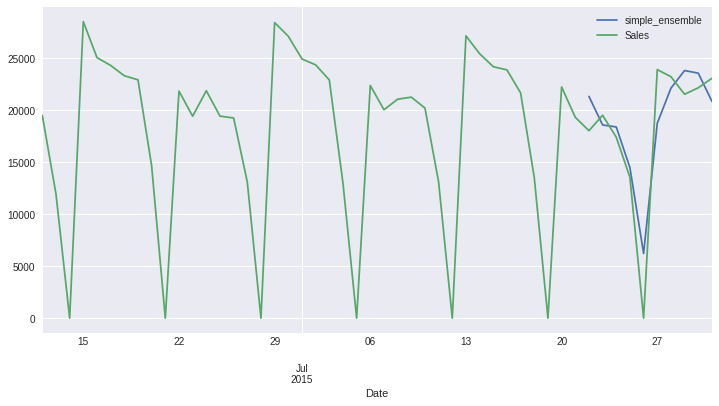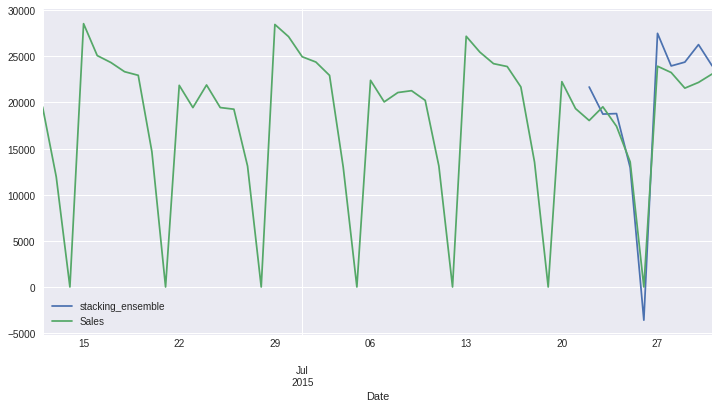Ensembles and Predictions Clipping¶
The combination of predictions from several methods to one forecast often leads to great performance improvements.
Simple Ensembles¶
The most common strategy just takes an average of all the forecast, which often leads to surprisingly good results, for more on this topic, see forecast combination chapter from Forecasting: Principles and Practice. hcrystalball implements SimpleEnsemble which provides a simple interface for putting together very diverse models. SimpleEnsemble model takes a list of any hcrystalball model wrapper instance(s) as base learners and aggregates
their prediction using ensemble_func.
[1]:
import pandas as pd
import numpy as np
import matplotlib.pyplot as plt
plt.style.use('seaborn')
plt.rcParams['figure.figsize'] = [12, 6]
[2]:
from hcrystalball.utils import get_sales_data
df = get_sales_data(n_dates=100,
n_assortments=1,
n_states=1,
n_stores=1)
X, y = pd.DataFrame(index=df.index), df['Sales']
[3]:
from hcrystalball.ensemble import SimpleEnsemble
from hcrystalball.wrappers import ProphetWrapper
from hcrystalball.wrappers import ExponentialSmoothingWrapper
from hcrystalball.wrappers import get_sklearn_wrapper
from sklearn.linear_model import LinearRegression
from sklearn.ensemble import RandomForestRegressor
[4]:
prophet = ProphetWrapper(
extra_seasonalities = [{
'name':'bi-weekly',
'period': 14.,
'fourier_order': 5,
'prior_scale': 15.0,
'mode': None
}]
)
[5]:
simple_ensemble = SimpleEnsemble(
base_learners=[
prophet,
ExponentialSmoothingWrapper(),
get_sklearn_wrapper(RandomForestRegressor)
],
ensemble_func = 'median')
[6]:
(simple_ensemble.fit(X[:-10], y[:-10])
.predict(X[-10:])
.merge(y, left_index=True, right_index=True, how='outer')
.tail(50)
.plot()
);

Stacking Ensembles¶
hcrystalball StackingEnsemble model is very similar to sklearn StackingRegressor, nice explanation of the concept could be also found here. Unfortunately, the sklearn version of the StackingEnsemble doesn’t allow us to enrich the meta_training_data by other features than predictions of base learners.
In the case of time-series forecasts, the additional features are the key to enabling the meta_model to successfully learn when each model performs best. It’s often the case that some model performs better during specific days (i.e. weekends/holidays/spikes) and other is better during more stable periods. The goal is to combine them appropriately.
To do that you can specify weekdays_as_features as True, which will enrich the meta_training_data with the day of the week features. Another way how to improve the performance of the stacking ensemble is to take into account that some models perform better on short horizons, and some on longer ones. To take this effect into account the horizons_as_features can be set to True, which creates an additional column per each horizon and enables the meta_model to learn this
representation. Another important aspect of StackingRegressor is that to obtain meta_model which can generalize well - it needs to be fitted on out-of-sample predictions - train_horizon and train_n_splits. If you set train_horizon=5 andtrain_n_splits=4 then the training set for meta_model will be 20 observations. It’s advisable to have train_horizon * train_n_splits = training set for meta_model as big as possible and have train_horizon which will
match the horizon of the StackingEnsemble itself.
Predictions Clipping¶
Meta model’s predictions can be clipped to certain range given clip_predictions_lower and clip_predictions_upper parameters and/or we can in the same way also restrict base_learners (see/try commented lines)
[7]:
from hcrystalball.ensemble import StackingEnsemble
[8]:
stacking_ensemble = StackingEnsemble(
base_learners=[
prophet,
ExponentialSmoothingWrapper(
# prediction bounds for ExponentialSmoothingWrapper base_learner predictions
# clip_predictions_lower=0.
# clip_predictions_upper=50_000.
),
get_sklearn_wrapper(
RandomForestRegressor
# prediction bounds for RandomForestRegressor base_learner predictions
# clip_predictions_lower=0.
# clip_predictions_upper=50_000.
)
],
train_horizon=10,
train_n_splits=3,
meta_model=LinearRegression(),
# prediction bounds for meta_model predictions
# clip_predictions_lower=0.
# clip_predictions_upper=50_000.
)
[9]:
(stacking_ensemble.fit(X[:-10], y[:-10])
.predict(X[-10:])
.merge(y, left_index=True, right_index=True, how='outer')
.tail(50)
.plot()
);
